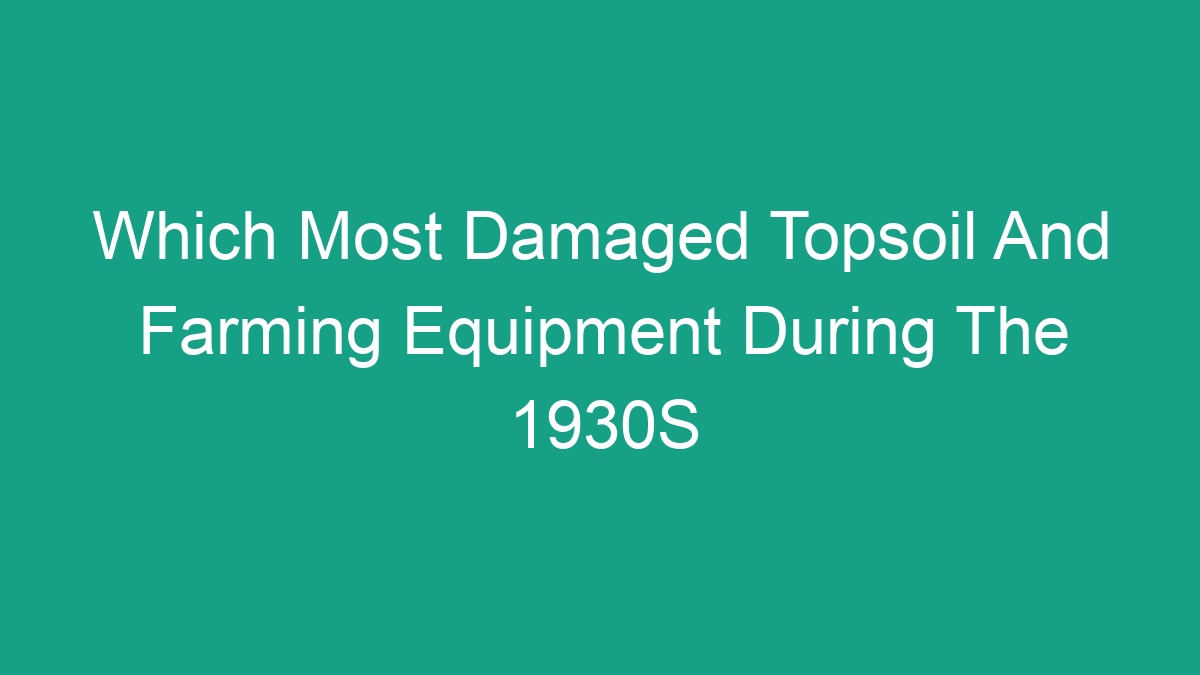
The Dust Bowl and Its Impact
The 1930s was a decade characterized by the Great Depression and the Dust Bowl, one of the most devastating environmental disasters in American history. The Dust Bowl was a period of severe dust storms that greatly damaged the topsoil of the American prairie regions during the 1930s. The impact of the Dust Bowl was extensive, affecting not only the topsoil but also farming equipment. In this article, we will explore which factors most damaged topsoil and farming equipment during the 1930s and how it influenced agriculture in America.
Topsoil Erosion
In the 1930s, the extensive cultivation of the Great Plains led to the loss of native grasses that held the soil in place. This, combined with severe drought and high winds, resulted in massive dust storms that swept across the region. The topsoil, which is the uppermost layer of soil and is crucial for plant growth, was greatly damaged by erosion. The loss of topsoil had a devastating impact on the fertility of the land, making it difficult for farmers to grow crops. The main factors that damaged topsoil during the 1930s were:
Poor Farming Practices: The practice of plowing the land to plant crops left the soil exposed to erosion. Without the natural grasses to hold the soil in place, it was easily picked up by the wind and carried away in massive dust storms.
Drought: The Great Plains region experienced severe drought during the 1930s, which dried out the soil and made it more susceptible to erosion. With little to no vegetation to hold the soil in place, the parched land was vulnerable to wind erosion.
High Winds: The strong winds that swept across the region exacerbated the problem of topsoil erosion. The loose, dry soil was easily lifted by the wind, creating massive dust storms that blanketed the area.
Damage to Farming Equipment
The Dust Bowl not only devastated the topsoil but also had a significant impact on farming equipment. The harsh conditions of the 1930s took a toll on the tools and machinery that farmers relied on to work the land. The following factors contributed to the damage of farming equipment during this period:
Dust: The incessant dust storms of the Dust Bowl infiltrated every nook and cranny, causing damage to the moving parts of farming equipment. Dust clogged machinery, corroded metal surfaces, and hampered the proper functioning of tools and implements.
Wear and Tear: The relentless work required to combat the effects of the Dust Bowl put a strain on farming equipment. Farmers had to work tirelessly to try and preserve their land and crops, leading to accelerated wear and tear on their tools and machinery.
Lack of Maintenance: The difficult economic conditions of the Great Depression meant that farmers often couldn’t afford the necessary maintenance and repairs for their equipment. As a result, their machinery suffered from neglect and deterioration.
Impact on Agriculture
The combined damage to topsoil and farming equipment during the 1930s had a profound impact on agriculture in America. The Dust Bowl forced thousands of farmers to abandon their land as it became increasingly infertile and unproductive. The loss of topsoil and the damage to farming equipment greatly reduced the ability of farmers to cultivate their crops and sustain their livelihoods.
The Dust Bowl also sparked a wave of migration, as many farmers and their families were forced to leave their homes in search of better opportunities elsewhere. This mass exodus had a significant social and economic impact on the affected regions and the country as a whole.
The agricultural practices and policies of the time were also called into question, leading to the implementation of new conservation practices and government programs aimed at preventing similar disasters in the future. The legacy of the Dust Bowl continues to shape the way we approach agriculture and land management today.
Conclusion
The 1930s was a decade marked by the devastating impact of the Dust Bowl on the topsoil and farming equipment of the American prairie regions. The extensive erosion of topsoil and the damage to farming equipment had far-reaching implications for agriculture in America. The lessons learned from this environmental disaster have informed our approach to land management and conservation practices, highlighting the importance of sustainable agriculture and the preservation of our natural resources. As we look to the future, it is crucial to remember the lessons of the past and work towards a more resilient and sustainable agricultural system.



